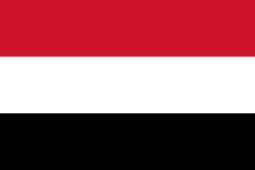|
Flag of Yemen
The national flag of Yemen (Arabic: علم اليمن, romanized: 'Alam al-Yaman) is the official flag of the Yemen. It was adopted on 22 May 1990, the day of the Yemeni unification. It resembles the Arab Liberation Flag that was used by the National Liberation Front. It served as the derivation for the flags of both North and South Yemen prior to their unification, and the distinctive elements of flag were removed in choosing the flag post-unification.[1]  According to the official description, the red stands for unity and the bloodshed of martyrs, the white for a bright future, and the black for the supposed dark past. The flag is graphically identical to the flag of the Libyan Arab Republic from 1969 to 1972.[1] ColorsConstruction sheet Meaning behind the colors
Color shades
Government flags
Regional flagsThe Federalization of Yemen or the Federal Republic of Yemen was the outcome of the National Dialogue Conference. The Dialogue members also agreed that Yemen would be transformed into a six-region federal system.[6] The regions would be Azal in the North, Saba in the center, Tihama in the West, Aden and Janad in the South, and Hadhramaut in the East.
Historical flagsBefore Yemen was unified into the present-day Republic of Yemen in 1990, it existed as two states, North and South Yemen. North YemenKingdom of YemenThe Kingdom of Yemen was never a British protectorate, it was nominally part of the Ottoman empire until 1918 and was independent thereafter. Independently, here were two British protectorates (known as the Eastern and Western Aden Protectorates) which contained 24 sultanates, emirates and sheikhdoms in the hinterland of Aden.[7] The flag was in use until 1962 when the imam was overthrown and the Yemen Arab Republic was established. A civil war between republicans (supported by Egypt) and royalists (supported by Saudi Arabia) continued until 1970, with the royalist side continuing to use the flag of the kingdom.[7] Meaning behind the flagThe five stars represent the five geographic regions of Yemen; they also recall the Five Pillars of Islam, and the prayers (Salah) five times a day.[7][8] The saber, widely used as an emblem by Arabs, and the red field on which it is placed, are reminders to the people of the blood they have sacrificed in defense of the liberty and independence of their country.[7]
Yemen Arab Republic
When the Yemen Arab Republic revolted against the imamate in 1962, a version of the Arab Liberation Flag with one green star in the center of the white band which symbolized unity and independence.[9]
South YemenThe flag of the People's Democratic Republic of Yemen in the South was a version of the Arab Liberation Flag with a light blue chevron which represented the people under the leadership of the National Liberation Front, with a red star next to the hoist representing the NLF itself and later the Socialist Party.[10][11] The flag was adopted on 30 November 1967 when South Yemen declared independence from the United Kingdom until the Yemeni unification in 1990.[10] It was used again for a few months in 1994 during the existence of the Democratic Republic of Yemen.
See alsoReferences
External links |
||||||||||||||||||||||||||||||||||||||||||||||||||||||||||||||||||||||||||||||||||||||||||||||||||

























